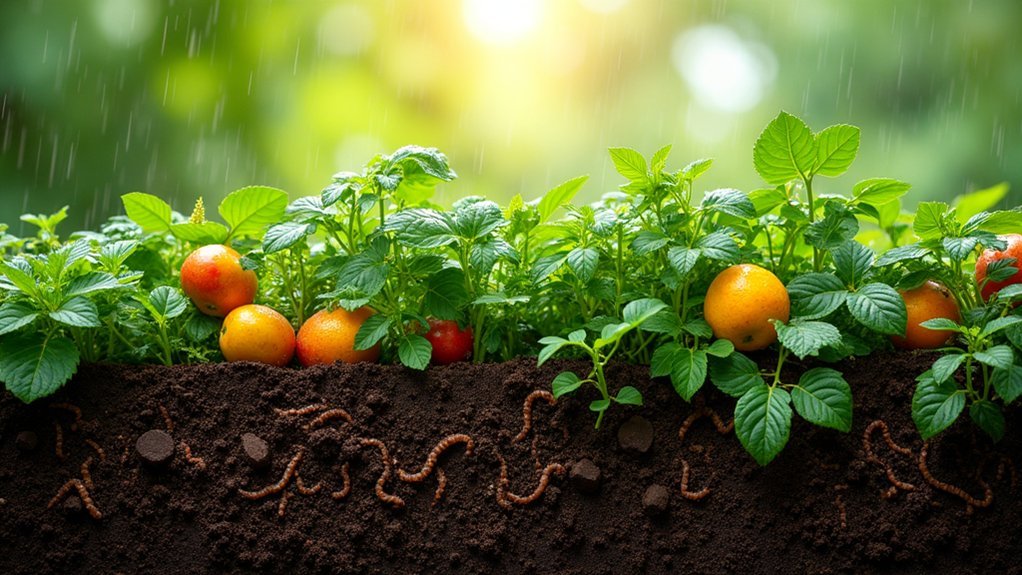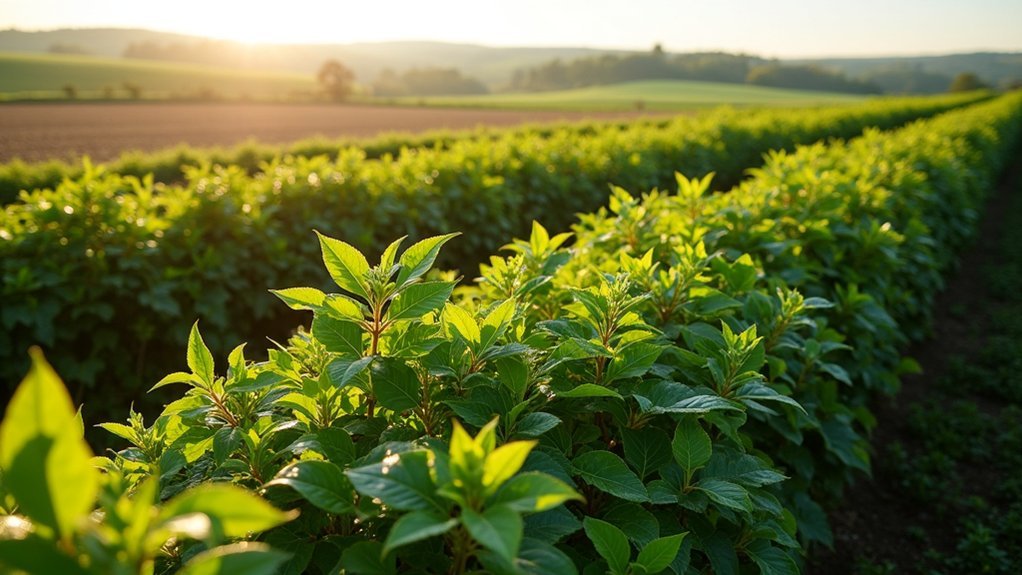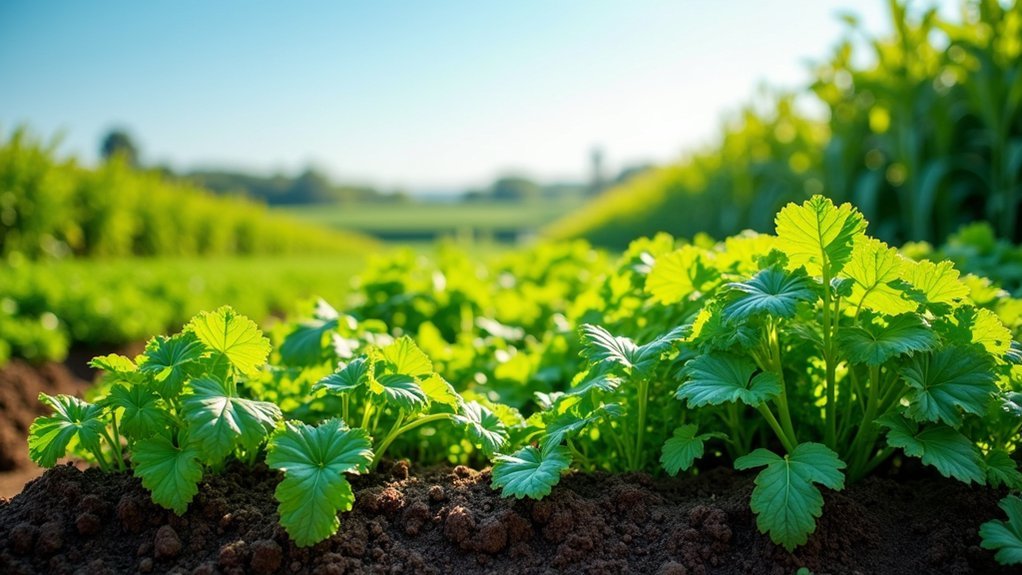Food hedges fight climate change by capturing up to five tons of carbon per hectare annually through their extensive root systems. You’ll see multiple benefits: improved soil health, enhanced biodiversity, better water management, and reduced agricultural emissions. Their strategic placement creates microclimates that protect crops against extreme weather while providing sustainable food sources. These living barriers also boost economic resilience for farmers through diverse harvests and lower input costs. The climate solution literally grows right in your backyard.
The Carbon Sequestration Power of Living Food Barriers

Five tons of carbon per hectare can be captured annually through the strategic planting of hedgerows, making living food barriers a formidable ally in climate change mitigation.
When you incorporate these living systems into your agricultural landscape, you’re effectively creating natural carbon sinks that pull CO2 from the atmosphere and lock it away in both plant biomass and soil.
The extensive root networks of hedgerows don’t just prevent soil erosion—they actively improve soil structure, enhancing its capacity to store carbon.
This dual action considerably reduces your farm’s carbon footprint while maintaining precious topsoil integrity. By preventing runoff, these living barriers guarantee carbon remains sequestered rather than released back into the atmosphere.
You’re not just growing food; you’re establishing a sustainable climate solution that works continuously, year after year.
How Food Hedges Enhance Biodiversity and Ecosystem Resilience
When you establish food hedges on your land, you’re creating wildlife superhighways that dramatically boost biodiversity across your agricultural ecosystem. These living barriers serve as essential corridors for species movement, enhancing genetic diversity and strengthening ecosystem resilience against climate challenges.
| Ecosystem Benefit | How It Happens | Climate Impact |
|---|---|---|
| Pollinator Haven | Diverse flowering species attract bees and butterflies | Improved crop yields without chemicals |
| Predator Habitat | Birds and beneficial insects find shelter | Natural pest control reduces pesticide need |
| Soil Protection | Root systems prevent erosion and build organic matter | Enhanced carbon sequestration capability |
Your hedgerows don’t just sequester carbon—they build complete ecosystems that withstand climate variability. By supporting diverse plant communities, you’re creating self-regulating systems that naturally resist pests and diseases while providing multiple ecological services to your farm.
Deep Root Systems: Nature’s Underground Climate Warriors

Beneath the visible beauty of your food hedges lies their true superpower—extensive root networks that transform soil ecology while fighting climate change.
These deep root systems create natural flood defenses by enhancing water absorption and reducing surface runoff during heavy rains.
Nature’s master engineers, transforming landscapes into living sponges that capture storm waters before they become flood threats.
You’ll find these underground networks silently preventing soil erosion while storing significant amounts of carbon—a critical climate mitigation service.
During droughts, their ability to access deeper water sources guarantees your hedgerows remain productive when other plants struggle.
Water Management Benefits of Edible Hedgerows
The remarkable water management capabilities of edible hedgerows extend far beyond their visible beauty.
You’ll find their deep root systems actively improving soil water absorption while reducing surface runoff.
When you plant these living barriers, you’re creating natural water engineers that absorb and transpire moisture, effectively managing the surrounding water table.
During heavy rainfall, hedgerow roots store excess water and delay its downslope movement, greatly reducing flood risks.
You’re also getting powerful erosion protection that prevents soil from washing away, decreasing siltation in nearby waterways.
As floodwaters encounter these green barriers, they slow down, allowing better soil infiltration and groundwater replenishment.
Soil Health Improvements Through Food-Producing Barriers

Food-producing hedgerows serve as powerful carbon capture champions, sequestering atmospheric CO2 in their diverse root systems and contributing to long-term soil carbon storage.
You’ll find these living barriers naturally improve soil structure while increasing organic matter content, creating a regenerative cycle that builds fertility without chemical inputs.
These boundary plantings also foster beneficial soil organisms that enhance nutrient cycling, turning what might otherwise be wasted field edges into productive zones of ecological restoration.
Carbon Capture Champions
While conventional agriculture often struggles with carbon emissions, strategically planted hedgerows serve as remarkable carbon capture champions in our farming landscapes.
You’ll find these living barriers actively sequestering carbon through their extensive root systems that stabilize soil and enhance nutrient cycling.
When you establish food-producing hedgerows, you’re creating powerful carbon sinks.
Their roots store more water, improving soil infiltration and reducing runoff, which leads to healthier soil capable of capturing more carbon.
The diverse habitats they provide foster rich microbial communities that further enhance carbon storage capacity.
Regenerative Boundary Benefits
Beyond their impressive carbon sequestration abilities, living food barriers transform the very foundation of agricultural systems—the soil itself. When you establish these productive hedgerows along your field boundaries, you’re creating natural engines of soil regeneration.
Their extensive root networks dramatically improve water absorption, reducing runoff and preventing valuable topsoil from washing away. Unlike conventional agriculture that generates food waste, these living boundaries continuously cycle nutrients back into the soil through leaf litter and organic matter decomposition.
You’ll notice decreased dependence on chemical fertilizers as hedgerows naturally enhance soil fertility. They also serve as windbreaks, protecting your crops from damage and preventing premature flower drop.
The diverse pollinators attracted to these boundaries further boost your yields while supporting a resilient ecosystem that withstands climate fluctuations better than monoculture systems alone.
Temperature Regulation and Microclimate Creation
As climate change intensifies weather extremes, food hedges emerge as natural temperature regulators for agricultural systems.
You’ll find these living boundaries create protective microclimates that buffer your crops against both scorching heat and damaging cold snaps.
During hot spells, hedgerows provide essential shade that reduces heat stress on plants, directly improving your yield potential.
Their structure breaks strong winds that would otherwise increase evaporation rates, helping maintain cooler soil temperatures around your crops.
The extensive root systems of food hedges enhance soil moisture retention, creating more stable growing conditions while reducing irrigation needs.
Food hedges’ deep roots hold precious moisture, stabilizing your garden’s microclimate while minimizing watering demands.
This temperature regulation effect attracts beneficial insects and pollinators that strengthen your garden’s resilience to climate fluctuations.
Reducing Agricultural Emissions With Strategic Food Hedges

Strategic food hedges can strengthen your climate resilience efforts by creating protected growing spaces that shield crops from extreme weather events.
You’ll find these natural barriers enable more localized food production, cutting transportation emissions while enhancing regional food security.
CEA Climate Resilience
While traditional agriculture struggles with climate volatility, food hedges offer powerful solutions for reducing agricultural emissions. These strategic plantings create windbreaks that shield crops from extreme weather, leading to healthier yields and lower carbon footprints.
You’ll find food hedges enhance climate resilience by naturally promoting biodiversity and supporting pollinators essential for sustainable food production.
The environmental benefits extend beyond just crop protection:
- Root systems improve soil water absorption, reducing irrigation needs and conserving precious water resources
- Hedgerows slow floodwater flow, preventing soil erosion and nutrient runoff that threatens waterways
- These living barriers sequester carbon effectively, transforming your agricultural landscape into a powerful climate change mitigation tool
Localized Production Benefits
Beyond enhancing climate resilience, food hedges offer remarkable opportunities for cutting emissions through localized production models.
When you implement strategic food hedges, you’re fundamentally creating a micro food system that dramatically reduces transportation needs. This localized production approach slashes carbon emissions typically generated by long-distance food shipping.
Your food hedges serve multiple emission-reducing functions simultaneously. Their diverse structure harbors beneficial insects that naturally control pests, reducing your need for chemical pesticides.
The extensive root systems improve soil health, preventing erosion while enhancing water absorption during heavy rainfall events.
These living boundaries don’t just protect your land—they actively sequester carbon, storing it in both woody biomass and soil.
Economic Benefits of Climate-Resilient Food Boundaries
As climate change continues to disrupt conventional farming practices, hedgerows represent an economically savvy adaptation strategy for forward-thinking farmers.
You’ll discover multiple economic benefits when implementing these living boundaries. By attracting beneficial insects, hedgerows can boost crop yields by up to 20%, greatly improving your farm’s productivity and profitability.
- Reduce input costs by decreasing pesticide needs, as hedgerows attract natural predators that control pest populations.
- Diversify revenue streams through additional products like fruits, nuts, and herbs, creating financial resilience against market fluctuations.
- Lower fertilizer expenses through improved soil health and nutrient cycling, while windbreak functions minimize crop damage during extreme weather events.
These climate-resilient boundaries don’t just protect the environment—they actively strengthen your bottom line while building sustainable agricultural systems for the future.
Food Security Through Perennial Hedge Systems

When traditional food systems falter under climate pressures, perennial hedge systems offer a resilient alternative that can transform your approach to food security.
Unlike annual crops vulnerable to climate fluctuations, these hedgerows provide continuous harvests of fruits, nuts, and vegetables year after year.
Perennial hedgerows deliver reliable yields when conventional systems collapse, feeding communities through climate chaos.
You’ll notice immediate benefits as deep-rooted perennials stabilize your soil, improve water retention, and cycle nutrients naturally.
This enhanced soil health directly supports sustained food production during unpredictable weather patterns.
Implementing Food Hedges: Practical Steps for Climate Action
You’ll find that food hedges offer practical local growing solutions that don’t require extensive land or resources.
By integrating these perennial systems into your community spaces or property boundaries, you’re creating sustainable food sources that naturally reduce waste through seasonal harvesting cycles.
These hedgerows enable you to harvest exactly what you need when it’s ripe, cutting down on food miles and packaging waste that plague conventional food systems.
Local Growing Solutions
The implementation of food hedges represents a practical approach to climate action that anyone can undertake in their community. When you plant diverse edible species along property lines or field boundaries, you’re creating a system that food generates while reducing carbon footprints.
You’ll notice fewer food miles as fruits and vegetables grow steps from your kitchen, eliminating transportation emissions.
- Your hedgerows become natural carbon sinks, sequestering CO₂ in both plant biomass and soil.
- Community food hedges create wildlife corridors, boosting pollinator populations essential for crop yields.
- These living boundaries provide microclimate benefits, protecting crops from extreme weather events.
Waste-Reducing Food Systems
Implementing food hedges into your agricultural landscape creates robust waste-reducing systems that combat climate change at multiple levels. They form natural habitats for predators that reduce pest damage, meaning less wasted food during production. You’ll also benefit from improved soil health that increases crop resilience.
| Hedge Benefit | Waste Reduction Impact |
|---|---|
| Natural predator habitat | Decreases pesticide use and crop loss |
| Windbreak protection | Prevents weather damage to vulnerable crops |
| Pollinator support | Enhances yield and quality of produce |
When you integrate hedgerows, you’re enhancing biodiversity while creating a self-regulating ecosystem that minimizes food waste from field to harvest. The stabilized nutrients and improved water absorption mean your crops receive maximum nourishment, further reducing losses that would otherwise contribute to emissions from wasted food.
Frequently Asked Questions
How Does the Food System Contribute to Climate Change?
Your food system fuels climate change through livestock’s methane emissions, wasted food’s decomposition, deforestation for farmland, and synthetic fertilizers releasing potent nitrous oxide—together causing about 25% of greenhouse gas emissions.
How Can You Help Fight Climate Change With Your Food Choices?
You can fight climate change by adopting a plant-based diet, buying organic and local foods, planning meals to reduce waste, and composting leftovers. These choices considerably lower your carbon footprint and greenhouse gas emissions.
How Does Eating Vegetables Reduce Climate Change?
Eating vegetables reduces climate change because you’re consuming food with a lower carbon footprint. When you choose veggies over meat, you’re cutting greenhouse gas emissions, requiring less land, and supporting farming practices that sequester more carbon.
How Can We Fight Climate Change by Reducing Food Waste?
You’ll fight climate change by planning your shopping, composting scraps, and using leftovers creatively. These actions prevent methane emissions from landfills and reduce the carbon footprint of food production and transportation.
In Summary
You’re witnessing a revolution in climate resilience through food hedges. They’re not just barriers—they’re carbon sinks, biodiversity hubs, and natural water managers with economic benefits. By implementing these living systems, you’re creating food security while actively fighting climate change. Start small, think long-term, and you’ll contribute to a solution that works with nature rather than against it. Your hedgerow matters.





Leave a Reply